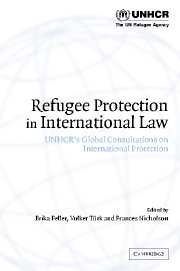Book contents
- Frontmatter
- Contents
- List of annexes
- Notes on contributors and editors
- Foreword
- Preface
- Acknowledgments
- Expert roundtables and topics under the ‘second track’ of the Global Consultations
- Table of cases
- Table of treaties and other international instruments
- List of abbreviations
- Part 1 Introduction
- 1.1 Refugee protection in international law: an overall perspective
- 1.2 Age and gender dimensions in international refugee law
- 1.3 Declaration of States Parties to the 1951 Convention and/or its 1967 Protocol Relating to the Status of Refugees
- Part 2 Non-refoulement (Article 33 of the 1951 Convention)
- Part 3 Illegal entry (Article 31)
- Part 4 Membership of a particular social group (Article 1A(2))
- Part 5 Gender-related persecution (Article 1A(2))
- Part 6 Internal protection/relocation/flight alternative
- Part 7 Exclusion (Article 1F)
- Part 8 Cessation (Article 1C)
- Part 9 Family unity (Final Act, 1951 UN Conference)
- Part 10 Supervisory responsibility (Article 35)
- Index
1.2 - Age and gender dimensions in international refugee law
Published online by Cambridge University Press: 28 August 2009
- Frontmatter
- Contents
- List of annexes
- Notes on contributors and editors
- Foreword
- Preface
- Acknowledgments
- Expert roundtables and topics under the ‘second track’ of the Global Consultations
- Table of cases
- Table of treaties and other international instruments
- List of abbreviations
- Part 1 Introduction
- 1.1 Refugee protection in international law: an overall perspective
- 1.2 Age and gender dimensions in international refugee law
- 1.3 Declaration of States Parties to the 1951 Convention and/or its 1967 Protocol Relating to the Status of Refugees
- Part 2 Non-refoulement (Article 33 of the 1951 Convention)
- Part 3 Illegal entry (Article 31)
- Part 4 Membership of a particular social group (Article 1A(2))
- Part 5 Gender-related persecution (Article 1A(2))
- Part 6 Internal protection/relocation/flight alternative
- Part 7 Exclusion (Article 1F)
- Part 8 Cessation (Article 1C)
- Part 9 Family unity (Final Act, 1951 UN Conference)
- Part 10 Supervisory responsibility (Article 35)
- Index
Summary
Context
International refugee law has evolved in significant ways over the last fifty years, as it has been required to adapt to new and changing refugee situations and humanitarian challenges. The removal of dateline and geographical limitations by virtue of the 1967 Protocol, and developments in other bodies of international law, have ‘fundamentally transformed the 1951 Convention from a document fixed in a specific moment in history into a human rights instrument which addresses contemporary forms of human rights abuses’. The Preamble to the 1951 Convention calls on States ‘to assure refugees the widest possible exercise of [their] fundamental rights and freedoms’, necessitating an analysis of refugee law within the wider humanitarian and human rights context. International human rights law and international humanitarian law instruments complement the safeguards for refugees enumerated in the 1951 Convention. Importantly, these bodies of law reinforce the non-discriminatory basis of international law in general, which impacts on international refugee law in particular. The text, object and purpose of the 1951 Convention require that it be interpreted and applied in a non-discriminatory way. The codification of women's and children's rights has also substantially advanced understandings of equal treatment and equal rights within the international refugee protection framework. Age and gender perspectives have thus become important features of international refugee law over the last decade.
This paper will consider, in particular, Articles 1A(2), 1F and 1C, from these perspectives, thus complementing the other papers in this book.
- Type
- Chapter
- Information
- Refugee Protection in International LawUNHCR's Global Consultations on International Protection, pp. 46 - 80Publisher: Cambridge University PressPrint publication year: 2003
- 10
- Cited by



